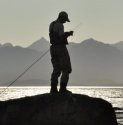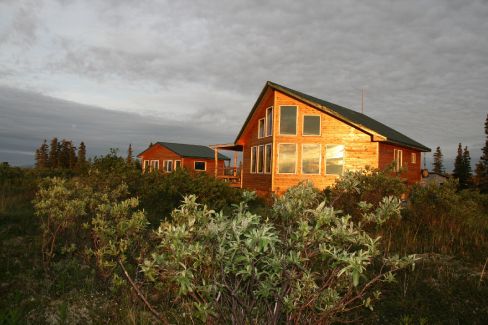Phil Monahan is one of the most recognized fly fishing editors of these times. He is the editor of OrvisNews.com and his articles on techniques, conservation, tying and pretty much everything regarding fly-fishing, are read by anglers from all over the world. Before becoming a key figure in fly-fishing publications, he guided in Alaska and Montana’s great waters. Then, he began working as the editor of American Angler magazine for almost ten years. It is our pleasure to share Phil’s interview with you.
FD: When did you start fly-fishing? Could you tell us about your memories from those times?
Phil: I have fished since childhood, but I didn’t become serious about fly fishing until I was in my 20s, when, after a few years working in New York City, I returned to my home turf in southeastern New Hampshire. My older brother, Brian—a much better fly fisherman than I was—lived nearby, and we began fishing together regularly. We ranged as far afield as the Androscoggin River, in the northeastern corner of the Granite State, but most of the time we fished the small ponds and streams that were within minutes of our homes—such unfabled waters as the Isinglass River and Stonehouse Pond. Although the sibling rivalry was always good-natured, we pushed each other to work hard at honing our fly-fishing skills. As a result, we both became better anglers.
FD: What can you tell us about your days working as a guide? What kind of waters did you fish and what are the moments that you still cherish the most about those experiences?
Phil: I guided in Alaska and Montana. In Alaska, I did everything from chasing pike in nameless ponds to casting to huge rainbows in some of the more famous rivers of the Bristol Bay Region. The specific moments that I remember most are those when everything came together between guide and angler to catch a fish. I wrote about one of those moments here: http://www.orvisnews.com/FlyFishing/The-Art-of-Pat...
FD: How was it that you decided to stop guiding and get into publishing in fly-fishing related publications?
Phil: I was guiding during the summer while working on a PhD in English Literature at Rutgers University in New Jersey. There came a point when I figured out that the career path I had chosen wasn’t a good fit for me, so I quit school and needed a job. Luckily, Outdoor Life magazine hired me as an editor, and my new career was off and running.
FD: Did you ever consider not working in the fly-fishing industry?
Phil: Well, since I kind of stumbled into it in the first place, yes. My original plan was to be a university professor. And when I was let go by American Angler in 2008, I did lots of different kinds of freelance writing and editing.
FD: What was it like to work as an editor for a leading magazine in the field, like American Angler?
Phil: It was both fun and a privilege. I got to spend every day thinking about a sport that I love, I was in contact with some of the greatest people in fly fishing, and I got to travel the world to catch fish (Argentina, Tasmania, Ireland, New Zealand, Quebec, Spain, etc.). What’s not to like? That’s not to say it wasn’t sometimes hard work. Most people assumed that I fished all the time when, in fact, I was chained to my computer.
FD: You have visited many places because of fly-fishing. Which are your favorite spots? Phil: My two favorite destinations have been New Zealand and the Spanish Pyrenees. They are completely different, yet wonderful. New Zealand has the incredible backcountry and huge fish; Spain has the history, food, and wine, as well as gorgeous rivers and trout.
FD: Could you tell us any funny story you recall from your trips?
Phil: My friend Sandy and I joked about the tiger snake the whole time we were fishing in Tasmania. It’s listed as one of the ten deadliest snakes in the world. So whenever we were walking through tall grass or bushes, we’d cry out, “Tiger snake!” in mock horror. Then, one evening we were following another car of anglers back from the Western Lakes, when we came around a corner of the road, and they were outside their stopped car, waving their arms for us to stop, too. When we got out, the screamed “Tiger snake!” and pointed to the road in front of their car. And there it was. To be honest, it didn’t look all that menacing, and it calmly slithered into the grass.
FD: Any risky situation you have been into?
Phil: On my last day as a guide in Alaska, my guests and I were at a remote lake in the bush. Because of mechanical troubles with the lodge’s big plane, we all had to be shuttled out in a 2-seat SuperCub on floats. It was getting dark when the pilot picked up the last two guests, leaving just me. The pilot looked at the sky and said, “I don’t know if I have enough light to make it back for you.” Since we had counted 24 different brown bears that day, I was not pleased with this prospect. I had about an hour to sit there and ponder what I was going to do all night to avoid being eaten. Luckily, he came back for me, but he had to make an almost blind landing on the lake back at the lodge.
FD: What spots and species are in your bucket list?
Phil: I need to catch a tarpon and a permit. I don’t care where. For destinations, I’d love to fish in Iceland, Scandinavia, and Scotland.
FD: Being a key figure in the online fly-fishing editorial world, have you got a particular aim or message to give out to the global fly-fishing community?
Phil: Not really. My main goal is to be entertaining and instructional, but always maintaining authenticity and credibility. There’s too much crap on the Internet, and it’s sometimes hard to separate good information from bad. I want folks to be certain that what they get from the Orvis Fly Fishing blog is solid, useful, and credible. It’s a reflection of the many brilliant anglers I work with every day in the office.
FD: What do you think about the internet regarding fly-fishing? What are the pros and cons?
Phil: As I noted above, the quality of information is the biggest problem. How do you know that someone is speaking the truth or if their opinion is tainted in some way? The Internet allows the free exchange of information, but it doesn’t self-edit or self-curate. You either have to do that work yourself or count on someone else, such as me or Marshall Cutchin at midcurrent.com, to do it for you. The Internet can be an incredible resource of how-to information, news distribution, etc. But it can also help spread misinformation and poorly constructed opinions.
FD: How do you envision the future of this sport?
Phil: I think it will continue to move away from a hard focus on trout. We will always love to catch trout, partially because they often live in such beautiful places, but the idea that any fish is fair game for the fly is growing. I have pictures in my email today of a guy who caught a sturgeon on a fly.
FD: Do you consider it important to know about fly-fishing history? Why?
Phil: I don’t think that it’s important, but I do think that it’s fun to know a little of what came before. Some people enjoy history in general, while others just want to enjoy the moment at hand. Both points of view are fine, in my book. When it’s just you and a rising trout, the fact that some guy invented the fly you’re going to use 100 years ago is mostly irrelevant.
FD: As a final point, what does fly-fishing mean to you?
Phil: You know, there’s a lot of literature devoted to this very question, and the search for meaning has a long history. But for me, it’s all about THE MOMENT. When I’m standing in a river or on the bow of a boat, I feel like the rest of my life is a long way off. Not that my life is so bad that I need to escape it, but that time on the water is an opportunity to recharge and just be fully present in the moment, without a lot of distraction, stress, or complication.








